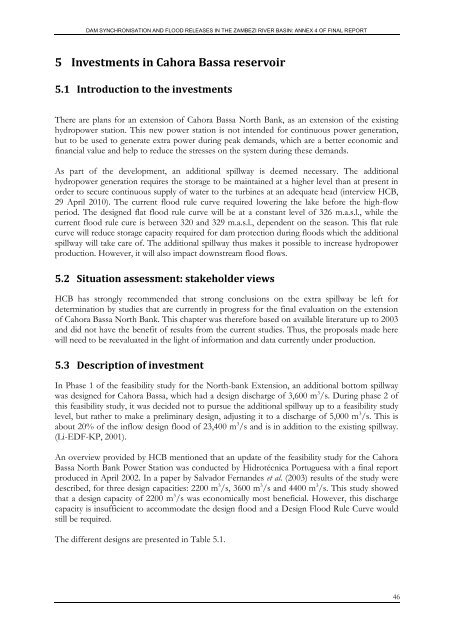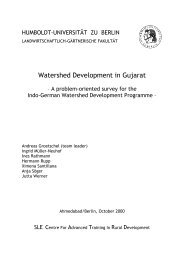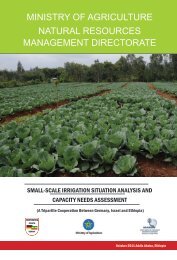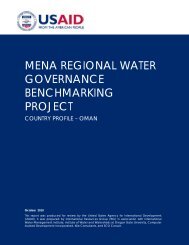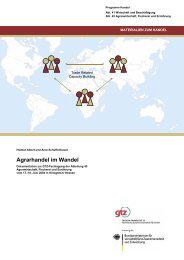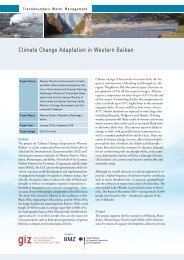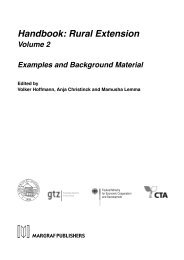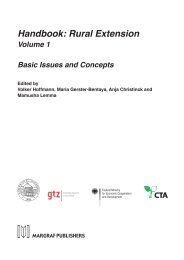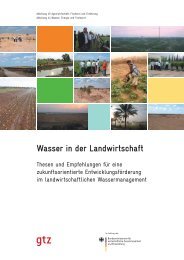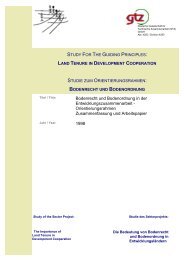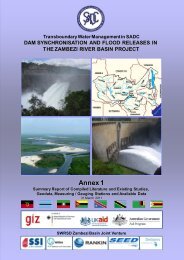Dam Synchronisation and Flood Releases - agriwaterpedia.info
Dam Synchronisation and Flood Releases - agriwaterpedia.info
Dam Synchronisation and Flood Releases - agriwaterpedia.info
You also want an ePaper? Increase the reach of your titles
YUMPU automatically turns print PDFs into web optimized ePapers that Google loves.
DAM SYNCHRONISATION AND FLOOD RELEASES IN THE ZAMBEZI RIVER BASIN: ANNEX 4 OF FINAL REPORT<br />
5 Investments in Cahora Bassa reservoir<br />
5.1 Introduction to the investments<br />
There are plans for an extension of Cahora Bassa North Bank, as an extension of the existing<br />
hydropower station. This new power station is not intended for continuous power generation,<br />
but to be used to generate extra power during peak dem<strong>and</strong>s, which are a better economic <strong>and</strong><br />
financial value <strong>and</strong> help to reduce the stresses on the system during these dem<strong>and</strong>s.<br />
As part of the development, an additional spillway is deemed necessary. The additional<br />
hydropower generation requires the storage to be maintained at a higher level than at present in<br />
order to secure continuous supply of water to the turbines at an adequate head (interview HCB,<br />
29 April 2010). The current flood rule curve required lowering the lake before the high-flow<br />
period. The designed flat flood rule curve will be at a constant level of 326 m.a.s.l., while the<br />
current flood rule cure is between 320 <strong>and</strong> 329 m.a.s.l., dependent on the season. This flat rule<br />
curve will reduce storage capacity required for dam protection during floods which the additional<br />
spillway will take care of. The additional spillway thus makes it possible to increase hydropower<br />
production. However, it will also impact downstream flood flows.<br />
5.2 Situation assessment: stakeholder views<br />
HCB has strongly recommended that strong conclusions on the extra spillway be left for<br />
determination by studies that are currently in progress for the final evaluation on the extension<br />
of Cahora Bassa North Bank. This chapter was therefore based on available literature up to 2003<br />
<strong>and</strong> did not have the benefit of results from the current studies. Thus, the proposals made here<br />
will need to be reevaluated in the light of <strong>info</strong>rmation <strong>and</strong> data currently under production.<br />
5.3 Description of investment<br />
In Phase 1 of the feasibility study for the North-bank Extension, an additional bottom spillway<br />
was designed for Cahora Bassa, which had a design discharge of 3,600 m 3 /s. During phase 2 of<br />
this feasibility study, it was decided not to pursue the additional spillway up to a feasibility study<br />
level, but rather to make a preliminary design, adjusting it to a discharge of 5,000 m 3 /s. This is<br />
about 20% of the inflow design flood of 23,400 m 3 /s <strong>and</strong> is in addition to the existing spillway.<br />
(Li-EDF-KP, 2001).<br />
An overview provided by HCB mentioned that an update of the feasibility study for the Cahora<br />
Bassa North Bank Power Station was conducted by Hidrotécnica Portuguesa with a final report<br />
produced in April 2002. In a paper by Salvador Fern<strong>and</strong>es et al. (2003) results of the study were<br />
described, for three design capacities: 2200 m 3 /s, 3600 m 3 /s <strong>and</strong> 4400 m 3 /s. This study showed<br />
that a design capacity of 2200 m 3 /s was economically most beneficial. However, this discharge<br />
capacity is insufficient to accommodate the design flood <strong>and</strong> a Design <strong>Flood</strong> Rule Curve would<br />
still be required.<br />
The different designs are presented in Table 5.1.<br />
46


